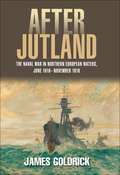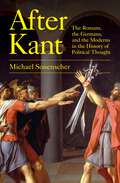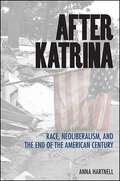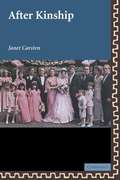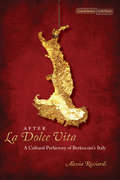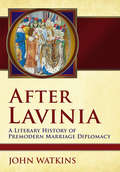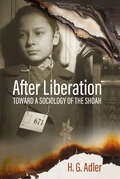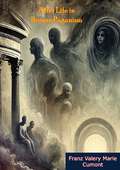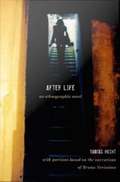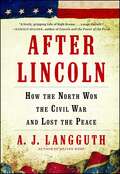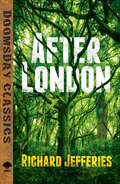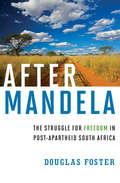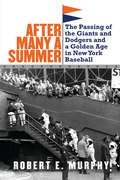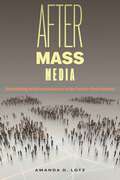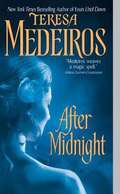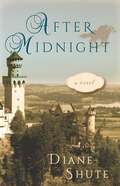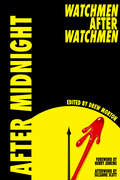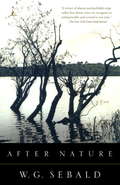- Table View
- List View
After Jihad: America and the Struggle for Islamic Democracy
by Noah FeldmanHow do we make democratic nations?
After Jutland: The Naval War in North European Waters, June 1916–November 1918
by James GoldrickThis is the story of the naval war in northern European waters following the critical if inconclusive battle of Jutland. There is a popular misconception that the battle marked the end of the operational career of the German High Sea Fleet. The reality is much more complex. The German battle fleet may have been quiescent in the North Sea, but it supported an ambitious amphibious campaign in the Baltic while an ever more bitter commerce war was waged by U-boats; and smaller warships of both sides fought a gruelling campaign in the waters of the English Channel and the Belgian Coast. While the book focuses primarily on the Royal Navy as the dominant maritime force, it also analyses the struggles of the beleaguered German Navy as it sought to find ways to break the tightening stranglehold of the Allied blockade. It includes an assessment of the small, but increasingly significant supporting role played by the French Navy from its bases in northern France, while the continuing conflict in the Baltic is explored as the Germans increased pressure on Russian territory and the Russian fleet, despite the descent into revolution, still managed to strike heavy blows at the Imperial German Navy. This period was one of great change. The Royal Navy improved the way that ships and their crews were organised for battle, and there were great leaps in communications and in command and control; aviation and undersea operations, including mine warfare, developed at breakneck pace. Both Germany and Russia undertook far more naval innovation and technological development in the final years of the War than is often realised, and by 1918 the protagonists were fighting what was, in every way, a multi-dimensional maritime war – the forerunner of the form of naval conflict of the remainder of the twentieth century. The author deals with the entry into the conflict of the United States and the increasing commitment of the US Navy to operations in Northern European waters. Many of the foundations of success in the next war were laid by the USN at this time, and there are strong links between the performance of all the navies and their experiences in 1939–45. Not only were doctrine and technology shaped by the events of the First War, so were the cultures of the various services and the characters of the individuals who would go on to serve in the highest ranks in the next. All of this makes the 1916-18 period so significant in naval history. In addition to his huge historical knowledge, the author brings his own extensive personal experience of naval operations and command at sea to this study, and this fusion of history with practical understanding sheds a unique and fascinating perspective on his analysis of the conflict.
After Kant: The Romans, the Germans, and the Moderns in the History of Political Thought
by Michael SonenscherTracing the origins of modern political thought through three sets of arguments over history, morality, and freedomIn this wide-ranging work, Michael Sonenscher traces the origins of modern political thought and ideologies to a question, raised by Immanuel Kant, about what is involved in comparing individual human lives to the whole of human history. How can we compare them, or understand the results of the comparison? Kant’s question injected a new, future-oriented dimension into existing discussions of prevailing norms, challenging their orientation toward the past. This reversal made Kant’s question a bridge between three successive sets of arguments: between the supporters of the ancients and moderns, the classics and romantics, and the Romans and the Germans. Sonenscher argues that the genealogy of modern political ideologies—from liberalism to nationalism to communism—can be connected to the resulting discussions of time, history, and values, mainly in France but also in Germany, Switzerland, and Britain, in the period straddling the French and Industrial revolutions.What is the genuinely human content of human history? Everything begins somewhere—democracy with the Greeks, or the idea of a res publica with the Romans—but these local arrangements have become vectors of values that are, apparently, universal. The intellectual upheaval that Sonenscher describes involved a struggle to close the gap, highlighted by Kant, between individual lives and human history. After Kant is an examination of that struggle’s enduring impact on the history and the historiography of political thought.
After Katrina: Race, Neoliberalism, and the End of the American Century
by Anna HartnellThrough the lens provided by the tenth anniversary of Hurricane Katrina, After Katrina argues that the city of New Orleans emerges as a key site for exploring competing narratives of US decline and renewal at the beginning of the twenty-first century. Deploying an interdisciplinary approach to explore cultural representations of the post-storm city, Anna Hartnell suggests that New Orleans has been reimagined as a laboratory for a racialized neoliberalism, and as such might be seen as a terminus of the American dream. This US disaster zone has unveiled a network of social and environmental crises that demonstrate that prospects of social mobility have dwindled as environmental degradation and coastal erosion emerge as major threats not just to the quality of life but to the possibility of life in coastal communities across America and the world. And yet After Katrina also suggests that New Orleans culture offers a way of thinking about the United States in terms that transcend the binary of national renewal or declension. The post-Hurricane city thus emerges as a flashpoint for reflecting on the contemporary United States.
After Kinship
by Janet CarstenAfter Kinship examines what has happened to kinship through various tropes: the house, gender, personhood, substance, and reproductive technologies. It is s much about what has happened to the anthropological study of kinship in recent years as it is about what has happened to our everyday experience of kinship.
After La Dolce Vita: A Cultural Prehistory of Berlusconi's Italy
by Alessia RicciardiThis book chronicles the demise of the supposedly leftist Italian cultural establishment during the long 1980s. During that time, the nation's literary and intellectual vanguard managed to lose the prominence handed it after the end of World War II and the defeat of Fascism. What emerged instead was a uniquely Italian brand of cultural capital that deliberately avoided any critical questioning of the prevailing order. Ricciardi criticizes the development of this new hegemonic arrangement in film, literature, philosophy, and art criticism. She focuses on several turning points: Fellini's futile, late-career critique of Berlusconi-style commercial television, Calvino's late turn to reactionary belletrism, Vattimo's nihilist and conservative responses to French poststructuralism, and Bonito Oliva's movement of art commodification, Transavanguardia.
After Lavinia: A Literary History of Premodern Marriage Diplomacy
by John WatkinsThe Renaissance jurist Alberico Gentili once quipped that, just like comedies, all wars end in a marriage. In medieval and early modern Europe, marriage treaties were a perennial feature of the diplomatic landscape. When one ruler decided to make peace with his enemy, the two parties often sealed their settlement with marriages between their respective families. In After Lavinia, John Watkins traces the history of the practice, focusing on the unusually close relationship between diplomacy and literary production in Western Europe from antiquity through the seventeenth century, when marriage began to lose its effectiveness and prestige as a tool of diplomacy.Watkins begins with Virgil's foundational myth of the marriage between the Trojan hero Aeneas and the Latin princess, an account that formed the basis for numerous medieval and Renaissance celebrations of dynastic marriages by courtly poets and propagandists. In the book's second half, he follows the slow decline of diplomatic marriage as both a tool of statecraft and a literary subject, exploring the skepticism and suspicion with which it was viewed in the works of Spenser and Shakespeare. Watkins argues that the plays of Corneille and Racine signal the passing of an international order that had once accorded women a place of unique dignity and respect.
After Liberation: Toward a Sociology of the Shoah<br/>Selected Essays
by H. G. Adler Jeremy AdlerH.G. Adler (1910–1988) was one of the founding figures of Holocaust scholarship whose monumental monograph Theresienstadt 1941-1945. The Face of a Coerced Community (1955; 1960) was the first study to present a fully documented account of the Final Solution. This collection gathers together, for the first time in English, some of Adler’s most important scholarly essays on the Shoah and connected themes. Ideas raised for the first time in his book on Theresienstadt are here taken up and developed at greater length, new accents are set, and new themes are explored. Spanning his thought across three decades they focus on the fate of the ‘coerced’ human being and reflect on freedom, enslavement, terror, concentration camps, persecution, the mass society, dread, loneliness, and ideology.
After Life in Roman Paganism
by Franz Valery Marie CumontAfter Life in Roman Paganism by Franz Valery Marie Cumont is a pioneering exploration of Roman beliefs about the soul, death, and the afterlife, offering deep insights into the spiritual and philosophical worldview of the ancient Roman world. Originally published in the early 20th century, Cumont’s work draws upon archaeological evidence, literary texts, and religious practices to paint a comprehensive picture of how Romans imagined the fate of the soul after death.The book delves into the complex tapestry of Roman religious traditions, highlighting how pagan views of the afterlife evolved over centuries through interactions with Greek philosophy, Eastern mystery cults, and local Italic practices. Cumont examines Roman funerary customs, beliefs in the underworld, and the notion of an immortal soul, providing readers with a nuanced understanding of how these ideas shaped both personal piety and public rituals. The influence of Stoicism, Epicureanism, and Platonism on Roman attitudes toward death is also explored, showing the interplay between philosophy and religious belief in everyday life.Cumont’s analysis goes beyond simple descriptions, investigating the emotional and psychological dimensions of these beliefs. He reflects on how Roman society used myths and rituals to cope with the uncertainties of death, offering comfort and meaning to the living. His work also highlights the gradual transition from traditional pagan beliefs to the rise of Christianity, providing a glimpse into the cultural shifts that accompanied the fall of the Roman Empire.For readers interested in ancient religion, philosophy, or the history of Roman civilization, After Life in Roman Paganism remains a landmark study. Cumont’s scholarship offers not just an account of religious practices but also a profound exploration of the human quest for meaning in the face of mortality—a quest that resonates across time and cultures.
After Life: An Ethnographic Novel
by Tobias HechtBruna Verssimo, a youth from the hardscrabble streets of Recife, in Northeast Brazil, spoke with Tobias Hecht over the course of many years, reliving her early childhood in a raging and destitute home, her initiation into the world of prostitution at a time when her contemporaries had scarcely started school, and her coming of age against all odds. Hecht had originally intended to write a biography of Verssimo. But with interviews ultimately spanning a decade, he couldn't ignore that much of what he had been told wasn't, strictly speaking, true. In Verssimo's recounting of her life, a sister who had never been born died tragically, while the very same rape that shattered the body and mind of an acquaintance occurred a second time, only with a different victim and several years later. At night, with the anthropologist's tape recorder in hand, she became her own ethnographer, inventing informants, interviewing herself, and answering in distinct voices. With truth impossible to disentangle from invention, Hecht followed the lead of Verssimo, his would-be informant, creating characters, rendering a tale that didn't happen but that might have, probing at what it means to translate a life into words. A call and response of truth and invention, mental illness and yearning, After Life is a tribute to and reinterpretation of the Latin American testimonio genre. Desire, melancholy, longing, regret, and the hunger to live beyond the confines of past and future meet in this debut novel by Tobias Hecht.
After Lincoln: How the North Won the Civil War and Lost the Peace
by A. J. LangguthA brilliant evocation of the post-Civil War era by the acclaimed author of Patriots and Union 1812. After Lincoln tells the story of the Reconstruction, which set back black Americans and isolated the South for a century.With Lincoln’s assassination, his “team of rivals,” in Doris Kearns Goodwin’s phrase, was left adrift. President Andrew Johnson, a former slave owner from Tennessee, was challenged by Northern Congressmen, Radical Republicans led by Thaddeus Stephens and Charles Sumner, who wanted to punish the defeated South. When Johnson’s policies placated the rebels at the expense of the black freed men, radicals in the House impeached him for trying to fire Secretary of War Edwin Stanton. Johnson was saved from removal by one vote in the Senate trial, presided over by Salmon Chase. Even William Seward, Lincoln’s closest ally, seemed to waver. By the 1868 election, united Republicans nominated Ulysses Grant, Lincoln's winning Union general. The night of his victory, Grant lamented to his wife, “I’m afraid I’m elected.” His attempts to reconcile Southerners with the Union and to quash the rising Ku Klux Klan were undercut by post-war greed and corruption. Reconstruction died unofficially in 1887 when Republican Rutherford Hayes joined with the Democrats in a deal that removed the last federal troops from South Carolina and Louisiana. In 1964, President Lyndon Johnson signed a bill with protections first proposed in 1872 by the Radical Senator from Massachusetts, Charles Sumner.
After London (Dover Doomsday Classics)
by Richard JefferiesA catastrophe has descended upon England. London is now a pestilent swamp, dotted with the ghostly remains of ancient buildings. A giant lake dominates the center of the country, towns have collapsed and given way to forests, and the few scattered survivors have descended into barbarism. Amid the ruins of civilization and a countryside ravaged by warring tribes, a lone hero undertakes a quest to prove himself worthy of his beloved. Characterized by the Observer as "the most beautiful of Victorian novels," this 1885 tale pioneered the post-apocalyptic genre of science fiction. Author Richard Jefferies was a noted naturalist, and his scientific expertise informs the evocative descriptions of birds, plants, and animals. An avid lover of wilderness, Jeffries devised a fantasy that places humanity in a state closer to nature. After London influenced William Morris, J. R .R. Tolkien, and countless other writers, and it remains a haunting tale of environmental collapse and dynamic adventure.
After Love: Queer Intimacy and Erotic Economies in Post-Soviet Cuba
by Noelle M. StoutFocused on the intimate effects of large-scale economic transformations, After Love illuminates the ways that everyday efforts to imagine, resist, and enact market reforms shape sexual desires and subjectivities. Anthropologist Noelle M. Stout arrived in Havana in 2002 to study the widely publicized emergence of gay tolerance in Cuba but discovered that the sex trade was dominating everyday discussions among gays, lesbians, and travestis. Largely eradicated after the Revolution, sex work, including same-sex prostitution, exploded in Havana when the island was opened to foreign tourism in the early 1990s. The booming sex trade led to unprecedented encounters between Cuban gays and lesbians, and straight male sex workers and foreign tourists. As many gay Cuban men in their thirties and forties abandoned relationships with other gay men in favor of intimacies with straight male sex workers, these bonds complicated ideas about "true love" for queer Cubans at large. From openly homophobic hustlers having sex with urban gays for room and board, to lesbians disparaging sex workers but initiating relationships with foreign men for money, to gay tourists espousing communist rhetoric while handing out Calvin Klein bikini briefs, the shifting economic terrain raised fundamental questions about the boundaries between labor and love in late-socialist Cuba.
After Mahler
by Stephen DownesThe music of Gustav Mahler repeatedly engages with Romantic notions of redemption. This is expressed in a range of gestures and procedures, shifting between affirmative fulfilment and pessimistic negation. In this groundbreaking study, Stephen Downes explores the relationship of this aspect of Mahler's music to the output of Benjamin Britten, Kurt Weill and Hans Werner Henze. Their initial admiration was notably dissonant with the prevailing Zeitgeist – Britten in 1930s England, Weill in 1920s Germany and Henze in 1950s Germany and Italy. Downes argues that Mahler's music struck a profound chord with them because of the powerful manner in which it raises and intensifies dystopian and utopian complexes and probes the question of fulfilment or redemption, an ambition manifest in ambiguous tonal, temporal and formal processes. Comparisons of the ways in which this topic is evoked facilitate new interpretative insights into the music of these four major composers.
After Mandela: The Struggle for Freedom in Post-Apartheid South Africa
by Douglas FosterThe most important historical and journalistic portrait to date of a nation whose destiny will determine the fate of a continent. A brutally honest exposé, After Mandela provides a sobering portrait of a country caught between a democratic future and a political meltdown. Recent works have focused primarily on Nelson Mandela's transcendent story. But Douglas Foster, a leading South Africa authority with early, unprecedented access to President Zuma and to the next generation in the Mandela family, traces the nation's entire post-apartheid arc, from its celebrated beginnings under "Madiba" to Thabo Mbeki's tumultuous rule to the ferocious battle between Mbeki and Jacob Zuma. Foster tells this story not only from the point of view of the emerging black elite but also, drawing on hundreds of rare interviews over a six-year period, from the perspectives of ordinary citizens, including an HIV-infected teenager living outside Johannesburg and a homeless orphan in Cape Town. This is the long-awaited, revisionist account of a country whose recent history has been not just neglected but largely ignored by the West.
After Many a Summer: The Passing of the Giants and Dodgers and a Golden Age in New York Baseball
by Robert E. MurphyBy the mid-1950s, New York had been the unrivaled capital of America’s national pastime for a century, a place where baseball was followed with truly fanatical fervor. The city’s three teams—the New York Yankees, the New York Giants, and the Brooklyn Dodgers—had over the previous decade rewarded their fans’ devotion with stellar performances: from 1947 to 1957, one or more of these teams had played in the World Series every year but one. Yet on opening day 1958, the Giants and the Dodgers were gone. Their owners, Walter O’Malley and Horace Stoneham, had ripped them away from their longtime home and from the hearts of millions of devoted and passionate fans and taken the teams to California. How did it happen? Who was to blame? The relocation of the Giants and the Dodgers, an event that transcended sports and altered the landscape of New York City, has never been addressed with the depth, detail, and insight offered here by Robert E. Murphy. As informed as it is entertaining, After Many a Summer is rich in baseball lore, civic history, and the wheeling and dealing, alliances and betrayals, and sharp-elbowed machinations of big-city business and politics.
After Mass Media: Storytelling for Microaudiences in the Twenty-First Century (Critical Cultural Communication)
by Amanda D. LotzExplores the cultural role of screen storytelling in societyWith significant evolutions in digital technologies and media distribution in the past two decades, the business of storytelling through screens has shifted dramatically. In the past, blockbuster movies and TV shows like Friends aimed first for domestic mass audiences, although the biggest hits circulated globally. Now, transnational distribution plays a primary role and imagined audiences are global. At the same time, the once-mass audience has significantly fragmented to enable an expansion in the range of commercially viable stories, as evident in series as varied as Atlanta, Better Things, and dozens of others that are not widely known, but deeply loved by their microaudiences.Delving into the changing landscape of commercial screen storytelling, After Mass Media explores how industrial shifts and technological advancements have remade the narrative landscape over the past two decades. Television and movies have long shaped society, whether by telling us about the worlds around us or far away. By examining the internationalization of screen businesses, the rise of streaming services with multi-territory reach, and the stories made for this environment, this book sheds light on the profound transformations in television and film production and circulation. With a keen focus on major changes in the types of screen stories being told, Amanda D. Lotz unravels the industrial roots that made these transformations possible, challenges some conventional distinctions of screen storytelling, and provides new conceptual tools to make sense of the abundance and range of screen stories on offer.Through its comprehensive analysis, After Mass Media exposes how contemporary industrial dynamics, particularly the erosion of traditional distribution models based on geography and mass audience reach, have far-reaching implications for our understanding of national video cultures.
After Midnight
by Teresa Medeiros"Our sister is marrying a vampire." When the ever practical Caroline Cabot first hears those words from the lips of her fanciful youngest sister, she accuses Portia of having a wild imagination. But when she discovers their sister Vivienne is actually being courted by Adrian Kane, the mysterious viscount rumored to be a vampire, she decides to accept his invitation to a midnight supper and do some sleuthing of her own. To both her delight and her dismay, she soon finds herself falling under Kane's bewitching spell. After all, what's a proper young lady to do when her sister's suitor arouses more than just her suspicions?
After Midnight: A Novel
by Diane ShuteAs far as Alix is concerned, she has no past—only today, and her plans for the future: creating a dynamic stable of Thoroughbreds that will take the 1830s British racing world by storm. When forced into assuming the role of Lord Griffon's wife in London, her plans are threatened by disturbing images of a castle from her past that fight to resurface. Alix is determined to find a way to take control of her life and fulfill her dreams. This women's historical fiction novel is the first in the Midnight Series.
After Midnight: A Novel (The Post-War Trilogy #1)
by Robert RyanA daughter&’s quest to find the father she never knew exposes deadly intrigue within the Italian Resistance in this spellbinding novel of World War II On the occasion of his only daughter&’s first birthday, Australian bomber pilot Bill Carr writes her a letter. Later that day, he takes off on a mission over the mountains of Northern Italy and is never heard from again. Twenty years later, Lindy Carr arrives in Italy to find out what happened to her father. Her guide is Jack Kirby, a daredevil motorcycle racer and pilot who flew Mosquito fighters in the war and spent time among the Italian partisans. Jack knows the region where Bill Carr vanished like his own backyard, and the farther he and Lindy push into the mountains, the more convinced he becomes that he knows something about the fatal flight in question as well. What Jack and Lindy uncover in the picturesque Italian Alps is a secret so earth shattering it will change both their lives forever. After Midnight is the 1st book in the Post-War Trilogy, which also includes Last Sunrise and Dying Day.
After Midnight: Watchmen after Watchmen
by Suzanne ScottContributions by Apryl Alexander, Alisia Grace Chase, Brian Faucette, Laura E. Felschow, Lindsay Hallam, Rusty Hatchell, Dru Jeffries, Henry Jenkins, Jeffrey SJ Kirchoff, Curtis Marez, James Denis McGlynn, Brandy Monk-Payton, Chamara Moore, Drew Morton, Mark C. E. Peterson, Jayson Quearry, Zachary J. A. Rondinelli, Suzanne Scott, David Stanley, Sarah Pawlak Stanley, Tracy Vozar, and Chris Yogerst Alan Moore and Dave Gibbons’s Watchmen fundamentally altered the perception of American comic books and remains one of the medium’s greatest hits. Launched in 1986—“the year that changed comics” for most scholars in comics studies—Watchmen quickly assisted in cementing the legacy that comics were a serious form of literature no longer defined by the Comics Code era of funny animal and innocuous superhero books that appealed mainly to children. After Midnight: “Watchmen” after “Watchmen” looks specifically at the three adaptations of Moore and Gibbons’s Watchmen—Zack Snyder’s Watchmen film (2009), Geoff Johns’s comic book sequel Doomsday Clock (2017), and Damon Lindelof’s Watchmen series on HBO (2019). Divided into three parts, the anthology considers how the sequels, especially the limited series, have prompted a reevaluation of the original text and successfully harnessed the politics of the contemporary moment into a potent relevancy. The first part considers the various texts through conceptions of adaptation, remediation, and transmedia storytelling. Part two considers the HBO series through its thematic focus on the relationship between American history and African American trauma by analyzing how the show critiques the alt-right, represents intergenerational trauma, illustrates alternative possibilities for Black representation, and complicates our understanding of how the mechanics of the show’s production can impact its politics. Finally, the book’s last section considers the themes of nostalgia and trauma, both firmly rooted in the original Moore and Gibbons series, and how the sequel texts reflect and refract upon those often-intertwined phenomena.
After Misogyny: How the Law Fails Women and What to Do about It
by Julie C. SukA rigorous analysis of systemic misogyny in the law and a thoughtful exploration of the tools needed to transcend it through constitutional change beyond litigation in the courts. Just as racism is embedded in the legal system, so is misogyny—even after the law proclaims gender equality and criminally punishes violence against women. In After Misogyny, Julie C. Suk shows that misogyny lies not in animus but in the overempowerment of men and the overentitlement of society to women's unpaid labor and undervalued contributions. This is a book about misogyny without misogynists. From antidiscrimination law to abortion bans, the law fails women by keeping society's dependence on women's sacrifices invisible. Via a tour of constitutional change around the world, After Misogyny shows how to remake constitutional democracy. Women across the globe are going beyond the antidiscrimination paradigm of American legal feminism and fundamentally resetting baseline norms and entitlements. That process, what Suk calls a "constitutionalism of care," builds the public infrastructure that women's reproductive work has long made possible for free.
After Modern Art, 1945-2000 (Oxford History Of Art)
by David HopkinsModern and contemporary art can be both baffling and beautiful; it can also be innovative, political, and disturbing. This book sets out to provide the first concise interpretation of the period as a whole, clarifying the artists and their works along the way. Closely informed by new critical approaches, it concentrates on the relationship between American and European art from the end of the Second World War to the eve of the new millennium. Jackson Pollock, Jasper Johns, Yves Klein, Andy Warhol, Louise Bourgeois, Cindy Sherman, and Damien Hirst are among many artists discussed, with careful attention being given to the political and cultural worlds they inhabited. Moving along a clear timeline, the author highlights key movements such as Abstract Expressionism, Pop Art, Minimalism, Conceptualism, Postmodernism, and performance art to explain the theoretical and issue-based debates that have provided the engine for the art of this period.
After Nature
by W. G. SebaldAfter Nature, W. G. Sebald's first literary work, now translated into English by Michael Hamburger, explores the lives of three men connected by their restless questioning of humankind's place in the natural world. From the efforts of each, "an order arises, in places beautiful and comforting, though more cruel, too, than the previous state of ignorance." The first figure is the great German Renaissance painter Matthias Grünewald. The second is the Enlightenment botanist-explorer Georg Steller, who accompanied Bering to the Arctic. The third is the author himself, who describes his wanderings among landscapes scarred by the wrecked certainties of previous ages. After Nature introduces many of the themes that W. G. Sebald explored in his subsequent books. A haunting vision of the waxing and waning tides of birth and devastation that lie behind and before us, it confirms the author's position as one of the most profound and original writers of our time.
After Nature: A Politics for the Anthropocene
by Jedediah PurdyNature no longer exists apart from humanity. The world we will inhabit is the one we have made. Geologists call this epoch the Anthropocene, Age of Humans. The facts of the Anthropocene are scientific--emissions, pollens, extinctions--but its shape and meaning are questions for politics. Jedediah Purdy develops a politics for this post-natural world.

